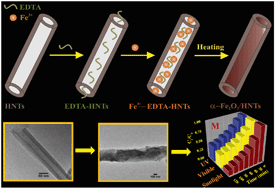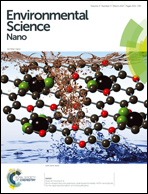A tubular nanoreactor directing the formation of in situ iron oxide nanorods with superior photocatalytic activity†
Abstract
We have demonstrated the use of the inner lumen of halloysite nanotubes as a nanoconfined reactor for the synthesis of nanoscale inorganic materials. Selective modification of the lumen has been carried out using a chelating ligand like ethylenediaminetetraacetic acid (EDTA) which selectively binds only to the alumina surfaces of the tubes and thus facilitates the adsorption of iron and subsequently the formation of nanoscale iron oxide within the lumen of the clay nanotubes. Lumen modification followed by the formation of iron oxide in the clay nanotubes has been evidenced by several physical methods, authenticating the successful incorporation of EDTA as well as formation of α-Fe2O3 nanorods inside the lumen and finally producing α-Fe2O3/HNTs nanocomposites that exhibit solar light-induced enhanced photocatalytic activity. This study represents the first demonstration of the selective modification of the halloysite lumen using a chelating ligand to direct the in situ synthesis of iron oxide nanorods. Thus, the selective lumen modification under mild conditions to produce novel inorganic–organic hybrid nanocomposites may open up a new direction in the frontier area of nanoconfined reactions and hence may impart a broader impact in the field of catalysis, environmental remediation and even in drug delivery.



 Please wait while we load your content...
Please wait while we load your content...